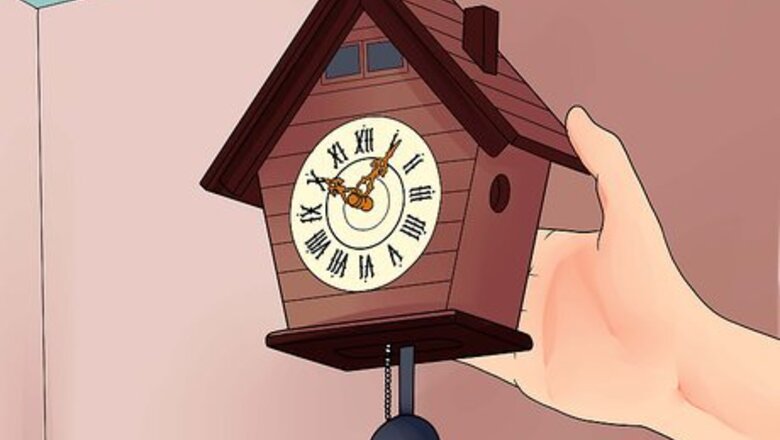
views
Preparing the Clock
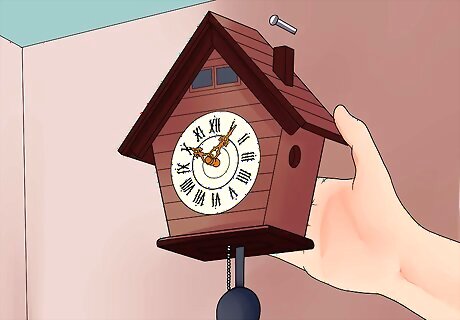
Keep the clock in a vertical position. Before setting the clock, you should hang it on the wall where you intend to keep it. The clock must be in an upright position before you can set it. The clock should be 6 to 6.5 feet (1.8 to 2 m) above the floor. Use wide wood screw (like a #8 or #10) that is long enough the fasten into a stud in the wall. You must choose a spot in the wall with a stud; do not attempt to hang the clock where no stud rests. Place the screw in the wall at an upward 45 degree angle. It should stick out by about 1.25 to 1.5 inches (3.2 to 3.8 cm). Hang the clock on this screw. The clock must be flush against the wall. If the chains are still in their packaging, slowly remove the packaging and loosen any knots. Pull out the security wire between them. Do not handle the chains in this manner while the clock is horizontal or upside down since doing so can cause the chains to come loose. One weight should be placed on each chain hook. Make sure that the pendulum rests on the hanger at the bottom of the clock, near the back.
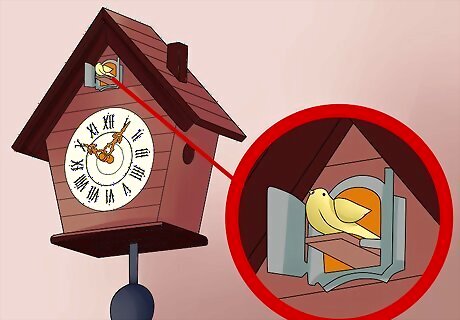
Unlatch the cuckoo door. If the cuckoo bird's door is kept closed with a wire latch, you need to move the latch aside. Failing to unlatch the door can prevent it from opening when it should. This can cause damage to your clock. If the cuckoo does not call at the appropriate time even with the door unlatched, check the wire latch again to make sure that it did not slip back into a locked position. You should also make sure that the shut-off switch is not flipped into a silent position (when applicable) and that all clips, rubber bands, and Styrofoam packing materials have been removed from inside the clock.
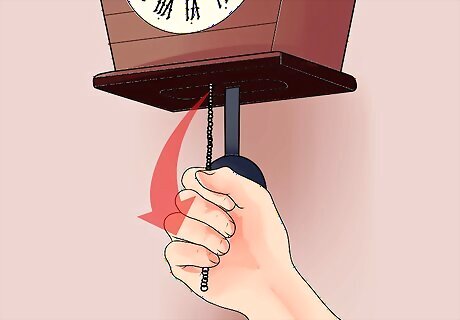
Wind the clock. Grab the chain that does not have a weight on it and gently pull it directly down toward the floor. Do not lift or otherwise touch the weighted chain as you wind the clock. There must always be some pressure on the weighted chain in order to keep it in place within the clock. The unweighted chain may have a ring on it.
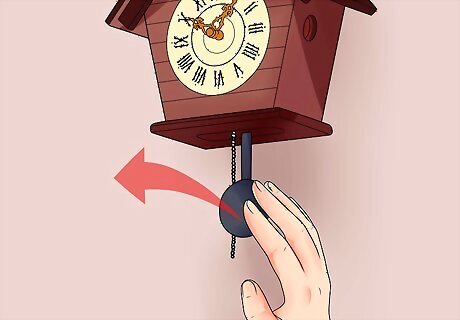
Nudge the pendulum. Gently nudge the pendulum to either side using your hands. It should continue swinging on its own after you start it. The pendulum should not rub against the clock cabinet and should swing freely. If this is not the case, then the clock probably isn't completely vertical. Readjust and try again. You should also listen to the ticking. If the clock does not tick evenly on both sides, you should readjust the straightness of the clock until the ticking sounds even. Handle the cuckoo clock gently when unpacking it. "My grandpa shipped me the beautiful cuckoo clock he once had in his Alpine chalet. I was scared to death of breaking the intricate inner parts while unpacking it! Reading these clear instructions on gently keeping the clock upright and not tugging the chains around calmed my nerves. Now, I feel ready to properly unbox my grandfather's treasured clock." - Sundaram R. Address multiple cuckoo clock issues. "Our family heirloom cuckoo clock stopped ticking correctly last month. Several gears seemed stuck. Unsure how to safely handle the old clock, I worried about causing more damage. But this article covers everything from pendulum motions to sound issues to winding techniques for antique clocks. After carefully following the steps, I got our generations-old clock back in working order! My grandma cried happy tears when it cuckooed on the hour again." - Jennifer S. We want to hear from you! Advice from our readers makes our articles better. If you have a story you’d like to share, tell us here.
Setting the Time
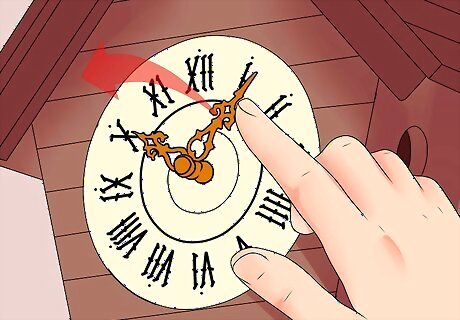
Turn the minute hand counterclockwise. Turn the long hand of the clock to the left until you reach the correct time. When done in this manner, the cuckoo call should set itself automatically. There is no need to pause and check the sound.
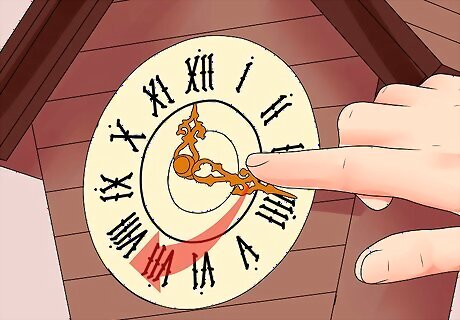
Alternatively, turn the minute hand clockwise and pause. If you turn the long hand to the right, you must pause at every hour ("12") and half hour ("6") mark before continuing to turn it. Wait for the cuckoo call to finish playing before you turn the minute hand any further past these marks. If you have a musical clock, wait for the melody to finish playing before you continue to turn the minute hand. When setting a cuckoo clock that has both cuckoo birds and quails, you will also need to stop at the quarter past ("3") and quarter until ("9") marks. Wait for the call or music to stop before continuing.

Never move the hour hand. Do not turn the shorthand at all when setting the clock. Turning the hour hand instead of the minute hand will damage the clock.
Regulating the Time
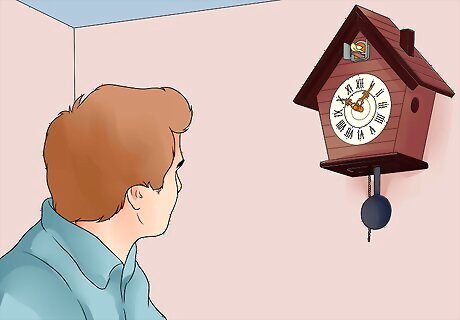
Observe the clock for 24 hours. Even if you purchased a new, pre-regulated cuckoo clock, you should observe it for a full 24 hours to determine if it is on time. After setting the original time, compare the time on the cuckoo clock to the time shown on another trusted clock, watch, or time-keeping device. Make sure to use a time-keeping device that can be trusted. Stick with a watch or similar device that has always been reliable in the past.
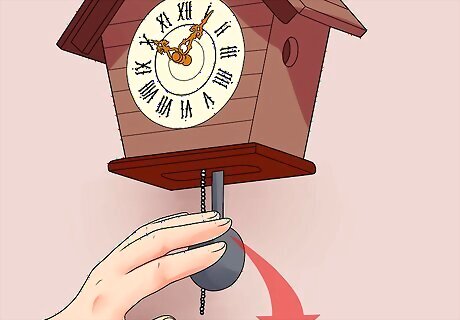
Move the pendulum down to slow the clock. If the clock runs too fast, slow it down by carefully moving the pendulum bob downward. This causes the pendulum to move slower. The bob will usually look like a weighted disc or leaf. Monitor the clock for the rest of the day to make sure that this adjustment was correct.
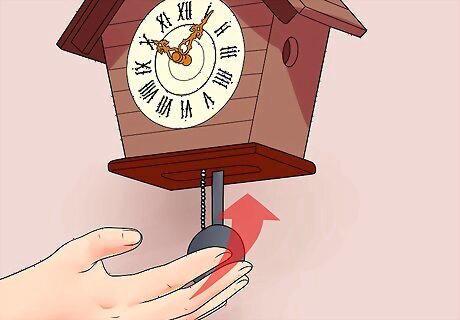
Move the pendulum up to speed up the clock. If the clock runs too slow, speed it up by carefully pushing the pendulum bob up. This causes the pendulum to swing faster. The pendulum bob will usually be in the shape of a leaf or weighted disc. Continue checking the clock's accuracy to determine if this adjustment was correct.
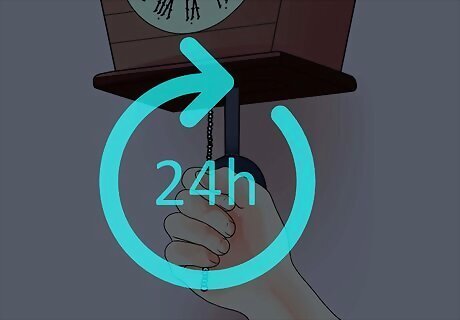
Wind as needed. The frequency with which you need to wind the clock will vary depending on the model, but you'll usually need to wind it once every 24 hours or once every eight days. Each time you wind the clock, do so in the same manner used to wind the clock initially. Pull the unweighted chain down to raise the weighted chain up as high as it will go without resistance.
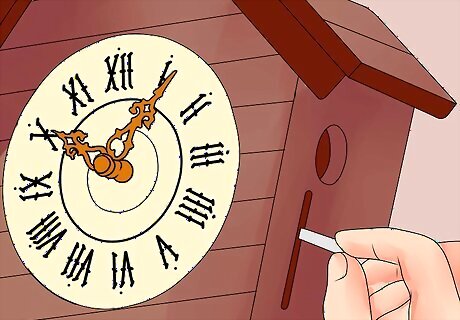
Adjust the cuckoo shut-off switch as needed. The cuckoo noise of some clocks can be switched of manually as desired. Make sure that the switch is adjusted to either play or mute the sound as desired. The switch can be found on either the bottom of the clock or to the left side. Usually, you will need to flip the switch off to turn off the cuckoo call and flip it down to turn the call back on again. This can vary by model, though, so you may need to check with the manufacturer to verify the correct way to use the manual shut-off switch. Never adjust this switch while the cuckoo call or song is actively playing. Note that this feature is not available on every model. It can be especially rare for vintage or antique cuckoo clocks.

















Comments
0 comment